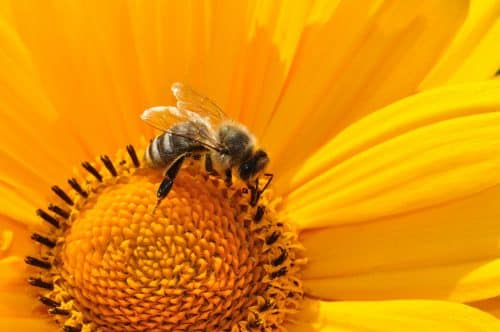A new study on the habits of the honey bee sheds new light on the physics of pollination processes and has implications for microelectromechanical systems (MEMS) in the future.

By: Dafna Haim-Langford
A joint study between the Georgia Institute of Technology in Atlanta, United States, and the Kiel University in Germany, examined how pollinating insects that deliberately wallow in millions of pollen are cleaned as part of the pollination mechanism, in a way that allows them to fly.
In their study, published in the journal Bioinspiration & Biomimetics, the researchers found that the key to optimal cleaning lies in the tiny hairs that cover the bees and other pollinating insects. It was also found that a viscous liquid on the surface of the pollen grains (Pollenkitt) is responsible for infecting the insect. Prof. Hu, one of the authors of the article, claims that the amount of pollen that may stick to a working bee can exceed five times the bee's body weight. Needless to say, in this situation, aviation, sensing and navigation become extremely challenging.
If so, how do the bees clean themselves of the pollen? The researchers found that hairs are used not only to collect pollen, but also for the cleaning process. It turns out that the hairs, depending on their location, are spread at such a distance that will allow the pollen to be moved away from the body, so that the bee can easily remove the pollen using the front legs. Accordingly, the spacing between the hairs on the front limbs dictates the amount of pollen that can stick to the limb and the amount of pollen it can remove in one movement.
The researchers performed an experiment to quantify this action. They photographed a honey bee covered in pollen using two cameras - one photographed the cleaning operations and the other the silhouettes of the pollen as they fall. This photo makes it possible to record the number of times the bee had to perform the cleaning operation and how many pollens it removed. In addition, the researchers recorded the geometry of the bee's movement and the spacing between hairs. In order to get as broad a picture as possible, the researchers examined different types of pollen that differed in size, weight, and geometry. Some of the stamens were washed to examine the effect of the mounting fluid on the cleaning/mounting process.
The experiment shows that the size of the pollen and the presence of the infection liquid are significant factors. It also shows that the smaller the particles, the longer the cleaning process takes. Washing off the coupling fluid, as expected, led to significantly lower adhesion.
It was also found that the ratio between the geometry of the hair in the cleaning area and the cleaning area dictates the cleaning effectiveness. Prof. Hu claims that based on the findings of the geometry of the hair on the bee's body in relation to the bee's legs, it is possible to design MEMS surfaces with greater resistance to dirt on the one hand and more efficient cleaning tools on the other.

One response
Interesting, only one important figure is missing and it is:
The structure of the front limbs has tiny "combs".
with the help of which the bee "combs" the pollen-bearing hairs
And so cleans them...